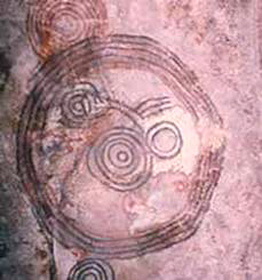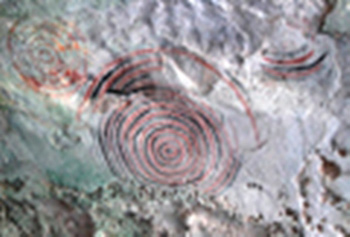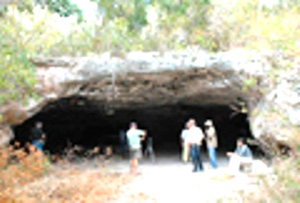Ancestral Heritage Story and a Case of Lazy Journalism
Vincent Morin Aguado

HAVANA TIMES – From the Isla de la Juventud, known in the old days as the Isla de Pinos, biologist Marbelis Castillo, Director of Cultural Heritage gives her views on the state of the prehistoric caves with hundreds of paintings there following a recent article in the official Granma newspaper. Being professionally linked in the past with this archaeological site, one of the most important in the Antilles, I have first-hand experience of the site.
The article by Orfilio Pelaez entitled “Ancestral Heritage in Desperate Need“, was based on a report of experts from the CITMA (Ministry of Science, Technology and Environment) and the National Council of Cultural Heritage warning of serious damage to the pictograms in Cave # 1 on Punta del Este, considered the main pre-Columbian site in the Caribbean.
I talked to Castillo on the phone and have summarized her reaction below.
HT: The Granma journalist talks about damage caused by algae and fungi that cover part of many drawings, and he also mentions human activity giving the impression the place is deserted and abandoned?
Marbelis Castillo: The journalist [Pelaez] has not visited the cave and is writing on the basis of the opinion of the specialists who visited the site months ago. There are misconceptions, but I’m a biologist and although I have only been in this new job for a month, I was running the museum of natural history before that. I can assure you that algae are out of the question because they are marine organisms and incompatible with a cave located on dry land.

HT: It should be mosses whose growth is due to photosynthesis caused by sunlight. The issue is not new. I visited the area on numerous occasions in the 1970s and 1980s as Director of the Municipal History Museum. I was privileged to share ideas with Dr. Antonio Nunez Jimenez, President of the Academy of Sciences of Cuba who was directly in charge of the study and systematization of Cuban cave art.
Nunez stressed the need to preserve the habitat as it was two thousand years ago, when it was populated by the aboriginal culture that created the wonderful and enigmatic paintings preserved there. The weather creates a delicate balance and changes in the weather can cause irreparable damage. On the subject of which the young biologist says:
MC: We have two cultural site promoters working full time, staying in the nearby weather station. You are not allowed to cut down trees or even to clear the surrounding area. There’s a trail which leads tourists and other visitors to the cave. Hurricane Gustav, the last hurricane we had, blew down trees in the area but the damage was not too bad and as far as I am concerned the landscape is practically unchanged from what it was decades ago.
HT: I remember the year 1981 when this remote area of pine forest in the southeast of the island, was declared a national monument. I went with Juan Colina La Rosa, Director of Cultural Heritage at the time, to erect a bronze plaque to mark the spot. I remember the lovely iron grille guarding the entrance to the cave.
MC: Well, Vicente, if there was a grille, it was many years ago because from 2000 when I became director of the Museum of Natural History which the protected area of Punta del Este comes under, I can assure you we never saw anything like that there.

HT: Marbelis points out other deficiencies in Pelaez’s Granma article:
MC: There is confusion when he talks about guns being fired, smoke from torches and people writing graffiti on the walls of the cave. Nothing like that happened, or could happen, in recent years, since our office has been managing the area and protecting it. These are things from the past that as a journalist he fails to clarify.
HT: I entirely agree with Marbelis having written a paper on potholing in 1985 which I presented at the first symposium on cultural history of the island. The fire and smoke from the torches bit of the story can be traced back to the 1920’s and 1930’s when a Galician troglodyte called Antonio Isla used the spacious cavern to live in.
As regards the signposts and that sort of thing, I can’t say much without visiting the site again. What worries me are the tourists. During my long years on the Island, visits were tightly controlled, it was even necessary to get a special permit from the Frontier Guards, an armed body of the Ministry of the Interior. So when I ask about that she says:
MC: Tourist visits have declined in recent years because of the poor state of the road leading to the site which is very remote and visitors have to go on foot to the cave, are not allowed to go by car, never by themselves but always accompanied by guides and our cultural promoters.

HT: What about the permits? Is the cave freely accessible?
MC: No, the same restrictions still apply. You still need a permit from the Guards.
HT: What can you do now about the whole business?
MC: The newspaper article was discussed with Heritage employees in a morning session. You can plant seeds but you need a permit from the forest authorities for that. I don’t think there have been any significant changes to the natural environment. We will also respond to what the journalist said.
HT: Many doubts still remain. There are theories suggesting that the materials used in the restoration of the drawings carried out in the sixties may have caused some damage. Tourism is always a danger; we know what money can do, despite the surveillance. Perhaps the grille ended up in somebody’s back yard. The truth is we are faced with an old problem with no obvious solution.
We are left with the caves, especially Number One, with its 213 paintings going back two thousand years. We urgently need to save what the learned Don Fernando Ortiz called the “Sistine Chapel of the Cuban aborigines.”
I’ll try to visit Punta del Este and when I do, promise you an overview of this ceremonial site, the most important of its kind in the Caribbean.
Vincent Morin Aguado : [email protected]





